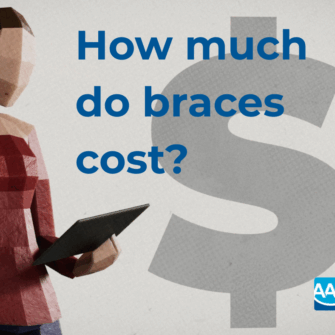Orthodontic treatment can be a lengthy process. Some patients wait years to get the dazzling smile they’ve always dreamed of. The feeling of relief when the braces finally come off is completely understandable, so you should take time to celebrate your new smile (perhaps by eating popcorn or any other delectable treats on the “do not eat with braces” list). AAO encourages you to enjoy this moment. It’s been a long time in the making, and you deserve it.
But it’s also important to remember that the end of your orthodontic treatment isn’t the end of your orthodontic journey. Many unfortunate patients are shocked and dismayed to learn that their teeth can continue to move even after orthodontic treatment is complete. As orthodontists, one of the most heartbreaking things we occasionally see is patients who choose not to wear their retainers, resulting in them having to return to our office in a year with teeth that have moved. Without a concerted effort to maintain their current position, your teeth will naturally attempt to return to their original positions.
In this guide, the experts at the American Association of Orthodontists (AAO) explain why teeth keep moving after treatment, and what you can do to keep your new smile from slipping away.
Why Do Teeth Move?
Change is a natural part of life. Just as our bodies change, so do our teeth. We start with no teeth, then get baby teeth, and eventually shed them for permanent teeth. Occasionally, issues arise with tooth placement and jaw alignment. That’s when the orthodontist steps in to fix misaligned teeth and jaws, creating a healthy and beautiful smile. However, after treatment, your teeth won’t stay in the position your orthodontist has moved them.
Tooth movements are the result of a lifelong natural process called bone remodeling. Bone remodeling occurs in all bones throughout the body, not just the teeth. It’s a cycle where new bone cells are created and older bone cells are reabsorbed. Our bones serve as both structural and functional components, forming the basis of our bodies, supporting our weight, and enabling movement. This requires them to be both rigid and flexible. Bone remodeling enables bones to adapt to our changing needs throughout life. However, it can also cause problems if bones are remodeled incorrectly. For example, if a broken bone isn’t placed in a cast or sling and allowed to rest at a certain angle while healing, the bone could be remodeled in a way that’s crooked and makes it more difficult for that bone to achieve its function.
Teeth are no exception. We apply force to them when we speak, bite, and chew. This force applied during bone remodeling causes the teeth to “drift” in the direction of the force. Additionally, misshapen jaws or gaps in teeth can further increase tooth movement because your teeth aren’t being supported correctly. This same process also enables orthodontic treatments to be effective. Braces and clear aligners move teeth by gradually applying controlled force in the direction your orthodontist wants to bring your teeth and jaws into alignment.
However, because tooth movement is a natural, lifelong process, your teeth will continue to move even after treatment.
How to Prevent Tooth Movement After Orthodontic Treatment
After spending so much time and money correcting your teeth and bite, it’s understandable you’d want everything to stay put. As orthodontists, we want your teeth to stay put, too. There’s really only one surefire way to keep your teeth from moving all over the place after treatment: Wear your retainer.
After your active treatment is completed, your orthodontist will take a mold or digital scan of your mouth to create a retainer. These orthodontic appliances are designed to “retain” your teeth in their current position, as their name suggests. Immediately after treatment, your orthodontist may instruct you to wear your retainer full-time, except when eating, drinking, or brushing your teeth. This is because there is a “settling in” period right after treatment ends, where your teeth are particularly prone to moving back to their original positions. This is often because constant force is no longer being applied to keep them from moving.
Eventually, your orthodontist may allow you to start wearing retainers only at night. Keep in mind that skipping your retainers for even a few days could cause your teeth to shift significantly. In order to combat the constant changes brought on by the bone remodeling process and forces applied to your teeth, you will likely need to wear retainers for the rest of your life.
What To Do if Your Retainer is Lost or Doesn’t Fit
If this happens, contact your orthodontist immediately. You’ll be asked to come in for an appointment, where we’ll assess your mouth and retainer and make any necessary adjustments to ensure you can continue to keep your smile safe. In some cases, we may need to remodel the retainer to account for changes in your mouth.
If you lose your retainer, please contact your orthodontist right away, as every day you don’t wear it is another day your teeth shift away from their post-treatment position. Replacement retainers can be a bit costly, but they’re still much cheaper than getting orthodontic treatment a second time to correct your bite again. To prevent losing your retainer, AAO recommends placing it in a plastic protective case when not in use. Never put retainers in your pockets or fold them up in napkins or paper towels. This is an easy way to either accidentally throw them away, have them go through the washer and dryer, or lose them altogether.
What to Do If Your Teeth Have Moved A LOT After Braces or Aligners
Have you noticed you’re having trouble biting again, or your teeth are no longer aligned when you bite down? Does your smile look crooked or odd?
While we hate to see it, if you’ve gone a while without wearing retainers, your teeth will have shifted significantly, and you may need to take additional steps to prevent them from moving. In cases like these, we typically begin by adjusting your retainer to correct your tooth movements. This may entail creating a new retainer to accommodate shifted teeth, or simply readjusting the existing retainer if it still fits but is too tight. We may ask you to return for follow-up appointments to continue adjusting your retainer until your teeth are back in their proper position after treatment.
If your teeth have shifted, wearing your retainer may no longer be sufficient to keep them in position. Some patients may be able to undergo a short treatment with braces or clear aligners to move their teeth again before reverting to retainers. In severe cases, a patient may be required to undergo another full round of orthodontic treatment.
To avoid having to undergo another costly round of treatment, it is advised to tell your orthodontist as soon as you start noticing significant tooth movement or your retainers don’t fit.
Frequently Asked Questions About Tooth Movements and Retainers
Keep Your Teeth from Moving After Orthodontic Treatment with AAO
After months or years of careful treatment, nothing is more rewarding for an AAO orthodontist than witnessing a patient’s first glimpse of their new smile. We live for the joy on patients’ faces at that moment. But conversely, there’s nothing that makes us sadder than to see a patient struggling again after treatment because their teeth have shifted back.
We want to help you keep your teeth and bite where they are after treatment for the rest of your life. If you need retainers replaced or adjusted, or if you may require retreatment, reach out to your nearest AAO orthodontist. Use our Find an Orthodontist tool to locate your nearest AAO orthodontist today.



